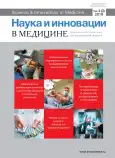Relapse of ovarian neoplasm: individual risk assessment algorithm
- Authors: Savinova A.R.1, Gataullin I.G.2
-
Affiliations:
- Tatarstan Regional Clinical Cancer Center
- Kazan State Medical Academy
- Issue: Vol 4, No 3 (2019)
- Pages: 65-68
- Section: Oncology
- URL: https://bakhtiniada.ru/2500-1388/article/view/43790
- DOI: https://doi.org/10.35693/2500-1388-2019-4-3-65-68
- ID: 43790
Cite item
Full Text
Abstract
Objectives – to develop an algorithm for assessing the individual risk of ovarian cancer recurrence.
Material and methods. A retrospective analysis of the results of treatment of patients with ovarian cancer in the period 2010–2015 was carried out. Finally, data of 1103 patients was reinvestigated, ovarian cancer relapse was registered in 907 patients (mean age: 58.7±12 years; interquartile range: 50–68 years). 196 patients with ovarian cancer did not have relapse for the mentioned time period (mean age: 63.1±13.6 years; interquartile range: 53–74 years). In the first stage of investigation, a unifactorial analysis of prognostic factors of ovarian cancer relapse was carried out. In the second stage, the most significant factors were analyzed with the aid of binary regression. As a result, a final formula of the assessment of individual risk of ovarian cancer relapse was developed, which we have named ARRNO (Algorithm of the Assessment of Risk of Relapse of Neoplasm of Ovary).
Results. From 12 prognostic factors, we selected 6 ones with the aid of binary regression: stage, hystotype, tumor differentiation grade, results of post-chemotherapy ultrasound examination, CA 125 pre-treatment levels, HE4 post-treatment levels. The final ARRNO score was developed on the basis of binary regression formula. Depending on the value of ARRNO score the risk could be divided into low (0.00–0.39), moderate (0.40–0.85) and high (0.86–1.00).
Conclusion. The algorithm of the risk assessment of recurrence of ovarian cancer has a high sensitivity and specificity and allows for stratification of patients into groups of high, moderate and low risk. Integration of the ARRNO in the follow-up plan of ovarian cancer patients, after accomplishment of the first-line therapy, could enhance the treatment planning and timely prevention.
Full Text
##article.viewOnOriginalSite##About the authors
Aigul R. Savinova
Tatarstan Regional Clinical Cancer Center
Author for correspondence.
Email: aigulkazan@mail.ru
ORCID iD: 0000-0001-7048-4125
oncologist of the Department of Oncology №10
Russian Federation, KazanIlgiz G. Gataullin
Kazan State Medical Academy
Email: aigulkazan@mail.ru
ORCID iD: 0000-0001-5115-6388
PhD, Professor of the Department of Oncology, Radiology and Palliative Care
Russian Federation, KazanReferences
- Baker TR, Piver MS. Etiology, biology, and epidemiology of ovarian cancer. Semin Surg Oncol. 1994;10(4):242–248.
- Holschneider CH, Berek JS. Ovarian cancer: epidemiology, biology, and prognostic factors. Semin Surg Oncol. 2000;19(1):3–10.
- Deraco M, Baratti D, Laterza B, et al. Advanced cytoreduction as surgical standard of care and hyperthermic intraperitoneal chemotherapy as promising treatment in epithelial ovarian cancer. Eur J Surg Oncol. 2011;37:4–9.
- Díaz-Montes TP, Bristow RE. Secondary cytoreduction for patients with recurrent ovarian cancer. Curr Oncol Rep. 2005;7:451–458.
- Klymenko Y, Nephew KP. Epigenetic crosstalk between the tumor microenvironment and ovarian cancer cells: a therapeutic road less traveled. Cancers (Basel). 2018;10(9):295. doi: 10.3390/cancers10090295
- Yang WL, Lu Z, Bast RC Jr. The role of biomarkers in the management of epithelial ovarian cancer. Expert Rev Mol Diagn. 2017;17(6):577–591. doi: 10.1080/14737159.2017.1326820
- Kensler TW, Spira A, Garber JE, et al. Transforming cancer prevention through precision medicine and immune-oncology. Cancer Prev Res (Phila). 2016;9(1):2–10.
- Escalona RM, Chan E, Kannourakis G, et al. The many facets of metzincins and their endogenous inhibitors: perspectives on ovarian cancer progression. Int J Mol Sci. 2018;19(2):450. doi: 10.3390/ijms19020450
- Rizzuto I, Stavraka Ch, Chatterjee J, et al. Risk of ovarian cancer relapse score. A prognostic algorithm to predict relapse following treatment for advanced ovarian cancer. Int J Gynecol Cancer. 2015;V.25:416–422.
- Savinova AR, Gataullin IG, Shakirov RR. Method of assessment of the risk of relapse of ovarian cancer. Patent of Russian Federation No.2251692, published on 10.05.2005, Bulletin No.13 (In Russ.) [Савинова А.Р., Гатауллин И.Г., Шакиров Р.Р. Способ оценки риска рецидивирования рака яичников. Патент Российской Федерации №2251692, опубликованный 10.05.2005, бюллетень №13].
- Savinova AR, Gataullin IG. Individual approach to the treatment of ovarian cancer. Kazan Medical Journal. 2016;V.97(3):P.388–393. (In Russ.) Савинова А.Р., Гатауллин И.Г. Индивидуальный подход к лечению рака яичников. Казанский медицинский журнал. 2016;V.97(3):P.388–393.
Supplementary files







